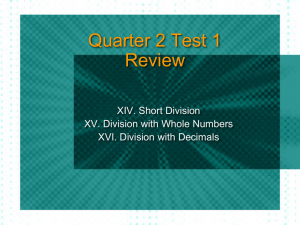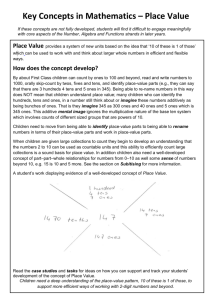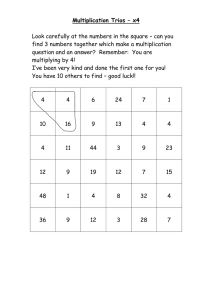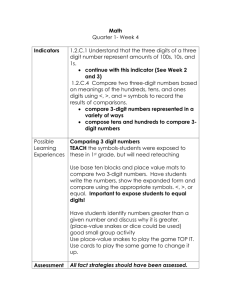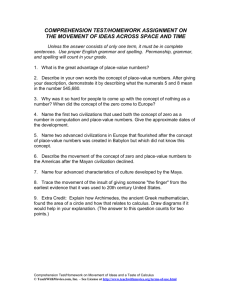Multiply With a One-Digit Multiplier Multiply With a One
advertisement
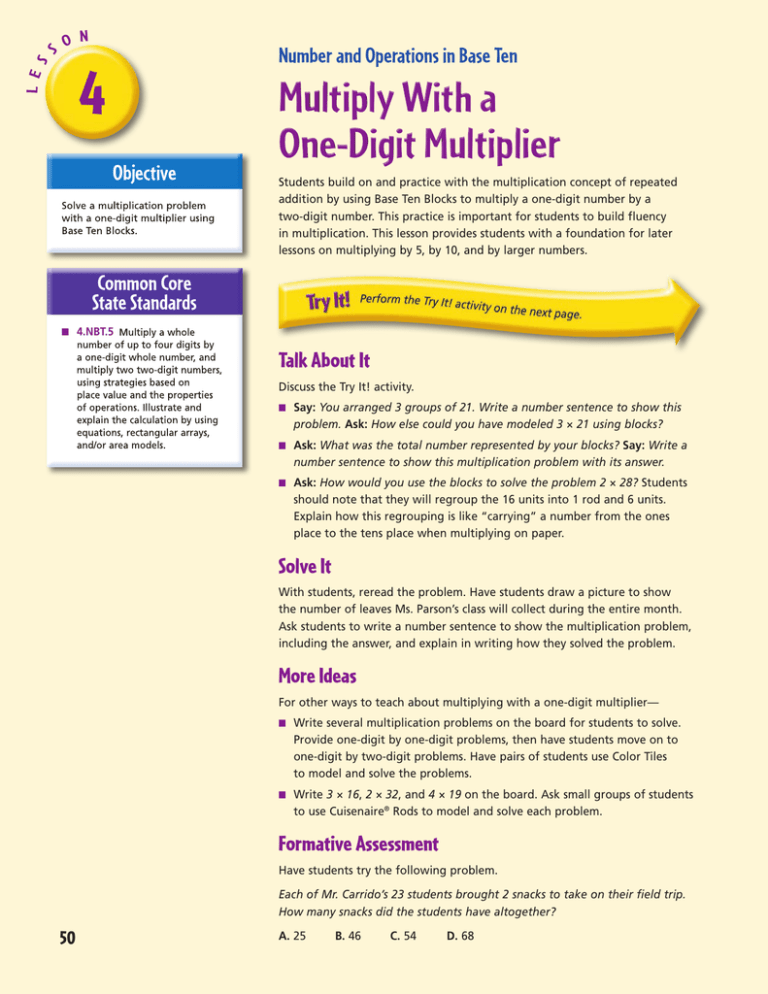
Number and Operations in Base Ten 4 Objective Multiply With a One-Digit Multiplier Students build on and practice with the multiplication concept of repeated addition by using Base Ten Blocks to multiply a one-digit number by a two-digit number. This practice is important for students to build fluency in multiplication. This lesson provides students with a foundation for later lessons on multiplying by 5, by 10, and by larger numbers. Common Core State Standards ■■ 4.NBT.5 Talk About It Discuss the Try It! activity. ■■ Say: You arranged 3 groups of 21. Write a number sentence to show this problem. Ask: How else could you have modeled 3 × 21 using blocks? ■■ Ask: What was the total number represented by your blocks? Say: Write a number sentence to show this multiplication problem with its answer. ■■ Ask: How would you use the blocks to solve the problem 2 × 28? Students should note that they will regroup the 16 units into 1 rod and 6 units. Explain how this regrouping is like “carrying” a number from the ones place to the tens place when multiplying on paper. Solve It With students, reread the problem. Have students draw a picture to show the number of leaves Ms. Parson’s class will collect during the entire month. Ask students to write a number sentence to show the multiplication problem, including the answer, and explain in writing how they solved the problem. More Ideas For other ways to teach about multiplying with a one-digit multiplier— ■■ Write several multiplication problems on the board for students to solve. Provide one-digit by one-digit problems, then have students move on to one-digit by two-digit problems. Have pairs of students use Color Tiles to model and solve the problems. ■■ Write 3 × 16, 2 × 32, and 4 × 19 on the board. Ask small groups of students to use Cuisenaire® Rods to model and solve each problem. Formative Assessment Have students try the following problem. Each of Mr. Carrido’s 23 students brought 2 snacks to take on their field trip. How many snacks did the students have altogether? 50 A. 25 B. 46 C. 54 D. 68 Try It! 20 minutes | Groups of 4 Here is a problem about multiplying with a one-digit multiplier. Materials Introduce the problem. Then have students do the activity to solve the problem. Distribute Base Ten Blocks and a Place-Value Chart (BLM 5) to groups of students. 1. Have students model 21 with the blocks. Instruct students to represent this number on their Place-Value Chart. 3. Have students find the total number represented by all the blocks. Say: Count all of your blocks. Ask: What number do you have? • Base Ten Blocks (30 units and 15 rods per group) • Place-Value Chart (BLM 5; 1 per group) • pencils (1 per group) Number and Operations in Base Ten Ms. Parson’s class collects 3 different types of leaves every day to study during science. Brian calculates that there will be 21 days of class this month. How can Brian find the total number of leaves the class will collect this month? 2. Say: We want to make 3 groups of 21. Arrange two more groups of 21 with blocks, then draw them on your Place-Value Charts. Watch for students who don’t grasp the concept of multiplication as repeated addition. Write 2 × 12 on the board. Say: You need to find the number 12 “two times.” So multiplying 12 by 2 is the same as adding 2 groups of 12 together. Have students model 2 × 12 with blocks and then on their Place-Value Charts. Point out to students that they have made a group of 12 two times. Then have students add to find the total. 51 Lesson 4 Name Number and Operations in Base Ten Answer Key Use Base Ten Blocks to build each expression. Write the multiplication expression and product. (Check students’ work.) 1. 3. 2. 32 2 64 22 4 88 13 3 39 _____ × _____ =_____ _____ × _____ =_____ _____ × _____ =_____ Build each problem using Base Ten Blocks. Sketch the model in a Place-Value Chart. Regroup as needed. Write the product. (Check students’ models.) 735 4 . 245 × 3 = _______________ Thousands Hundreds Tens Ones Tens Ones 4,248 5 . 2,124 × 2 = _______________ Thousands Hundreds 52 190 6. 38 × 5 = ________ 64 7. 16 × 4 = ________ 663 8. 221 × 3 = _______ 3,120 9. 1,560 × 2 = _____ 792 1 0. 132 × 6 = _______ 468 1 1. 117 × 4 = _______ Hands-On Standards, Common Core Edition Download student pages at hand2mind.com/hosstudent. © ETA hand2mind™ Find each product. Name Key Answer Challenge! How many of each Base Ten Block do you have before regrouping when you multiply 46 × 3? Explain how to regroup to write the product. Draw a picture to help. Challenge: (Sample) 12 rods and 18 units; 18 units regroups to 1 rod and 8 units. One rod added to the 12 rods make 13 rods. Thirteen rods regroups to 1 flat and 3 rods. The model of the product has 1 flat, 3 rods, and 8 units. The product is 138. © ETA hand2mind™ Download student pages at hand2mind.com/hosstudent. Hands-On Standards, Common Core Edition 53 Lesson 4 Number and Operations in Base Ten Name Use Base Ten Blocks to build each expression. Write the multiplication expression and product. 1. 3. 2. _____ × _____ =_____ _____ × _____ =_____ _____ × _____ =_____ Build each problem using Base Ten Blocks. Sketch the model in a Place-Value Chart. Regroup as needed. Write the product. 4 . 245 × 3 = _______________ Thousands Hundreds Tens Ones Tens Ones 5 . 2,124 × 2 = _______________ Thousands Hundreds 52 6. 38 × 5 = ________ 7. 16 × 4 = ________ 8. 221 × 3 = _______ 9. 1,560 × 2 = _____ 1 0. 132 × 6 = _______ 1 1. 117 × 4 = _______ Hands-On Standards, Common Core Edition www.hand2mind.com © ETA hand2mind™ Find each product. Name Challenge! How many of each Base Ten Block do you have before regrouping when you multiply 46 × 3? Explain how to regroup to write the product. Draw a picture to help. © ETA hand2mind™ www.hand2mind.com Hands-On Standards, Common Core Edition 53 Hundreds Tens 152 152 Ones 5 BLM 5 Place-Value Chart © ETA hand2mind™ Thousands Place-Value Chart BL M Name
